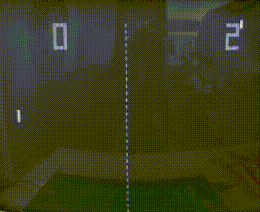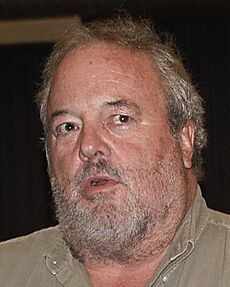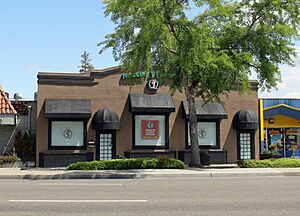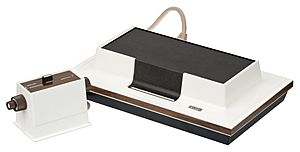Pong facts for kids
Quick facts for kids Pong |
|
|---|---|
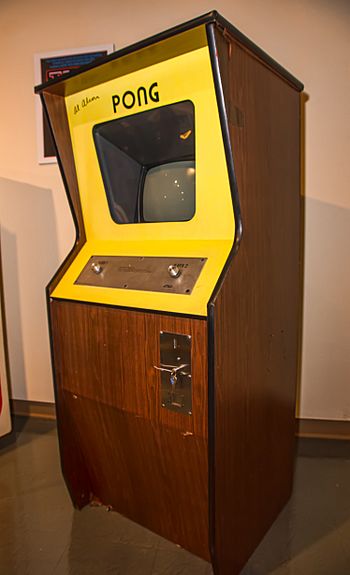
An upright cabinet of Pong on display at the Neville Public Museum of Brown County
|
|
| Developer(s) | Atari |
| Publisher(s) |
|
| Designer(s) | Allan Alcorn |
| Platform(s) |
|
| Release date(s) | |
| Genre(s) | Sports |
| Mode(s) | Single-player, multiplayer |
Pong is a classic arcade video game that looks like a simple game of table tennis. It has basic two-dimensional pictures and was made by Atari. It first came out on November 29, 1972.
Pong was one of the very first arcade video games ever made. Allan Alcorn created it as a practice project given to him by Atari's co-founder, Nolan Bushnell. Bushnell and his co-founder, Ted Dabney, were really impressed with Alcorn's work. They decided to make the game for everyone to play. Bushnell got the idea from an electronic ping-pong game he saw on the Magnavox Odyssey, which was the first home video game system. Because of this, Magnavox later sued Atari for using a similar idea.
Pong was the first video game to become a big commercial success. It helped start the whole video game industry along with the Magnavox Odyssey. After Pong came out, many companies started making games that looked and played very much like it. Eventually, other companies made new types of video games that were different from Pong. This encouraged Atari to create even more new and exciting games themselves.
Atari also made several follow-up games to Pong that added new features. In 1975, Atari released a home version of Pong just for Sears stores. This home version was also a huge hit and led to many other companies making their own versions. Pong has been remade for many different game systems over the years. It's even part of the permanent collection at the Smithsonian Institution in Washington, D.C., because it had such a big impact on culture.
Contents
How to Play Pong
Pong is a two-dimensional sports game that feels like playing table tennis. You control a paddle on the screen by moving it up and down on either the left or right side. You can play against another person who controls a second paddle on the other side. Players use their paddles to hit a ball back and forth. The main goal is to be the first player to score eleven points. You get a point when your opponent fails to hit the ball back to your side.
Making the Game: Pong's Story
Pong was the first game that Atari ever developed. After making a game called Computer Space, Nolan Bushnell decided to start a company to create more games. He hired Allan Alcorn because Alcorn knew a lot about electrical engineering and computers. Before working at Atari, Alcorn had never made a video game. Bushnell first wanted to make a driving video game, but he worried it might be too hard for Alcorn's first project.
To help Alcorn get used to making games, Bushnell gave him a secret warm-up task. Bushnell told Alcorn he had a deal with General Electric and asked him to create a simple game. This game needed one moving dot, two paddles, and a way to keep score. Bushnell said the game was inspired by electronic tennis games he had played before. However, Alcorn has said it was directly inspired by Bushnell seeing the Magnavox Odyssey's Tennis game. Bushnell had played the Magnavox Odyssey demo in May 1972 and, even though he thought it wasn't great, it gave him the idea for Alcorn's project.
Alcorn looked at Bushnell's plans for Computer Space, but they were hard to understand. So, he made his own designs based on his knowledge of electronics and Bushnell's idea. Alcorn felt the basic game was a bit boring, so he added cool features to make it more fun. He split the paddle into eight parts to change the ball's angle when it hit. For example, hitting the ball with the middle of the paddle sent it straight back. Hitting it with the outer parts sent it at different angles. He also made the ball go faster the longer it stayed in play. If you missed the ball, its speed would reset. Another interesting feature was that the paddles couldn't reach the very top of the screen. This was actually a small flaw in the circuit. Instead of fixing it, Alcorn decided it made the game harder and kept players from playing forever if they were really good.
About three months into making the game, Bushnell told Alcorn he wanted realistic sound effects and a cheering crowd. Alcorn didn't have much space for extra electronics and wasn't sure how to make those sounds. He then found a way to create different tones using parts of the game's video signal system. He used these for the game's simple sound effects. To build the first Pong machine, Alcorn bought a $75 Hitachi black-and-white TV. He put it into a 4-foot tall wooden cabinet and wired up the necessary circuits. Bushnell and Dabney were so impressed with this prototype that they thought it could be a big hit. They decided to test it out.
In August 1972, Bushnell and Alcorn put the Pong prototype in a local bar called Andy Capp's Tavern. They chose this bar because they had a good relationship with the owner, Bill Gaddis. The game was placed on a table near other entertainment machines like a jukebox and pinball games. Pong was a huge hit from the first night and became even more popular over the next week and a half. Bushnell then went to Chicago to show Pong to other game companies. A few days later, the prototype started having problems. Alcorn went to fix it and found that the coin slot was overflowing with quarters!
After hearing about the game's success, Bushnell decided Atari should make the game themselves instead of letting other companies do it. But other companies were already interested. Bushnell had trouble finding money to build Pong machines. Banks thought it was just like pinball, which people at the time linked to the Mafia. Eventually, Atari got a loan from Wells Fargo to build a factory. The company announced Pong on November 29, 1972. They hired workers, but couldn't make enough machines to keep up with demand. At first, they made only about ten machines a day, and many didn't pass quality checks. Atari eventually got better at it and started making more. By 1973, they were shipping Pong to other countries.
In Japan, Pong was officially released in November 1973 by Atari Japan. However, two Japanese Pong-like games, Sega's Pong Tron and Taito's Elepong, had already come out in July 1973.
Bringing Pong Home: The Console Version
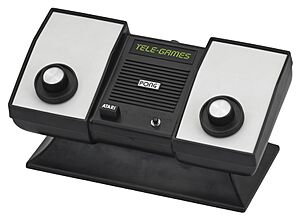
After Pong's success, Bushnell wanted his team to create new products. A new electronic part called a large-scale integration (LSI) chip had just become available. Bushnell believed this chip would help them make new kinds of games. Atari started working on shrinking the big Pong arcade machine's parts down to a small LSI chip for a home system. Making the first chip was expensive, costing around $50,000. But once the chip was made, it became much cheaper to make many copies of the game. It also made it harder for other companies to copy the game.
In 1974, Atari engineer Harold Lee suggested a home version of Pong that could connect to a TV. They called it Home Pong. The project was secretly named Darlene, after an Atari employee. Alcorn worked with Lee to design and build the first model. They used the same digital technology as their arcade games. They worked in shifts to save time and money. Lee designed the logic during the day, and Alcorn fixed problems with the designs in the evenings. After the designs were approved, another Atari engineer, Bob Brown, helped them build a working model. This model was a device connected to a wooden stand with over a hundred wires. These wires would eventually be replaced by a single chip designed by Alcorn and Lee. The chip was finished in late 1974 and was one of the most powerful chips used in a home product at the time.
Bushnell and Gene Lipkin, Atari's sales vice-president, tried to sell Home Pong to toy and electronics stores, but they were turned down. Stores thought it was too expensive and wouldn't interest customers. Bushnell then contacted Sears after seeing a Magnavox Odyssey ad in their catalog. Atari staff met with a Sears representative, Tom Quinn, who was very excited about the game and offered Atari an exclusive deal. Atari's leaders thought they could find a better deal elsewhere, so they said no and kept trying toy stores. In January 1975, Atari showed Home Pong at a trade show in New York City, but they still couldn't get any orders because of the high price.
While at the show, they met Quinn again. A few days later, they set up another meeting with him to get a sales order. To get approval from Sears' Sporting Goods department, Quinn suggested Atari show the game to executives in Chicago. Alcorn and Lipkin went to the Sears Tower. Even with a small technical problem caused by an antenna on the building, they got approval. Bushnell told Quinn he could make 75,000 units in time for Christmas. However, Quinn asked for double that amount! Even though Bushnell knew Atari couldn't make 150,000 units, he agreed. Atari got money from an investor to buy a new factory. This factory, led by Jimm Tubb, managed to complete the Sears order. The first units, branded with Sears' "Tele-Games" name, started selling around late October to mid-November 1975. They cost $98.95 and came with a one-year warranty. Atari later released its own version in 1976.
Pongs Big Impact
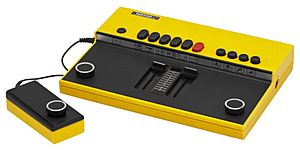
The Pong arcade games made by Atari were a huge success. People at Andy Capp's Tavern loved the prototype. They would come to the bar just to play the game. After it was released, Pong consistently made four times more money than other coin-operated machines. Bushnell thought the game earned about $35–40 every day, which was something he had never seen before in the entertainment business. Because the game made so much money, Atari received many more orders. This gave Atari a steady income. The company sold the machines for three times what they cost to make. By 1973, they had sold 2,500 orders, and by the end of 1974, over 8,000 units. These old arcade machines are now collector's items. Soon after Pong's success, other companies started visiting the bar to check it out. Similar games appeared on the market just three months later. Atari couldn't do much about these copycat games because they hadn't gotten patents for the technology right away. When they did try to get patents, it took a long time. As a result, the market was full of "Pong clones." One author estimated that Atari made less than a third of these machines. Bushnell called the competitors "Jackals" because he felt they had an unfair advantage. His way of competing was to make even more new and exciting games.
Home Pong was an instant hit after its limited release through Sears in 1975. About 150,000 units were sold that holiday season. The game became Sears' most successful product at the time. Atari's own version sold another 50,000 units. Just like with the arcade version, many companies released their own versions to make money from the home console's success. Many of these companies continued to make new consoles and video games. Magnavox re-released their Odyssey system with simpler parts and new features. Coleco entered the video game market with their Telstar console, which had three Pong variations. Nintendo released the Color TV-Game 6 in 1977, which had six versions of electronic tennis. The next year, they released an updated version with fifteen variations. These systems were Nintendo's first steps into the home video game market.
Many experts believe Pong was the game that started the video game industry as a profitable business. Video game author David Ellis calls the game the "cornerstone" of the industry's success. He also called the arcade game "one of the most historically significant" titles. The release of the home version is seen as the successful start of home video game consoles. In 1995, Flux magazine ranked Pong as the 56th best video game. In 1996, Next Generation magazine called it one of the "Top 100 Games of All Time." In 2015, The Strong National Museum of Play added Pong to its World Video Game Hall of Fame.
Bushnell felt that Pong was special because it helped people connect. Since it was only for two players and didn't need both hands, it was easy for people to play together. He said it was common for someone to ask another person to play, and they would sit side-by-side, talk, laugh, and challenge each other. Many people have told him they met their future husband or wife playing Pong, which he thinks is a nice thing to have achieved.
Other Versions and Remakes
Atari made Pong available on many different game systems. In 1977, Pong and several similar games were part of Video Olympics, one of the first games for the Atari 2600.
Pong has also been included in many Atari game collections on different systems. You can find it in Arcade Classics on the Sega Genesis, and with Asteroids and Yars Revenge on the Game Boy Advance. It's also in Atari Classics Evolved for the PlayStation Portable, Retro Atari Classics on the Nintendo DS, and Atari: 80 Classic Games in One! for personal computer. It's even in the Atari 50: The Anniversary Celebration (2022) collection for Nintendo Switch, PlayStation 4, Steam, and Xbox One.
Bally Gaming and Systems even made a slot machine version of the game. Pong was also included as a mini-game on the loading screens of the PlayStation 2 and Xbox versions of TD Overdrive: The Brotherhood of Speed.
New Pong Games and Follow-ups
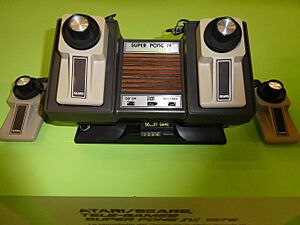
Bushnell believed the best way to beat competitors was to make better games. This led Atari to create follow-up games in the years after the original Pong. These included Pong Doubles, Super Pong, Quadrapong, and Pinpong. These new games looked similar but had new ways to play. For example, Pong Doubles let four players play in pairs, while Quadrapong had them compete against each other on a four-sided field. Bushnell also thought of a free version of Pong to keep kids busy in a doctor's office. He first called it Snoopy Pong and made the machine look like Snoopy's doghouse. But he changed it to Puppy Pong and used a generic dog to avoid legal issues. Bushnell later used this game in his Chuck E. Cheese's restaurants. In 1976, Atari released Breakout, a single-player game based on Pong. In Breakout, you hit a ball to break bricks in a wall. Like Pong, Breakout also had many games that copied its style, such as Arkanoid and Alleyway.
In 1999, Hasbro Interactive released a new game called Pong: The Next Level for home computers and the PlayStation. This game was part of a trend where popular arcade games were remade with 3D graphics and new art styles. This game also had many power-ups.
In 2012, Atari celebrated Pong's 40th birthday by releasing Pong World for iOS devices. In 2020, a new game called Pong Quest was released by Atari on Steam, PlayStation 4, Xbox One, and Nintendo Switch. A new version of Pong has also been announced for the Intellivision Amico.
Images for kids
See also
 In Spanish: Pong para niños
In Spanish: Pong para niños


